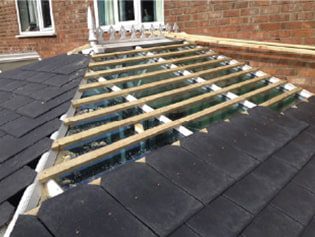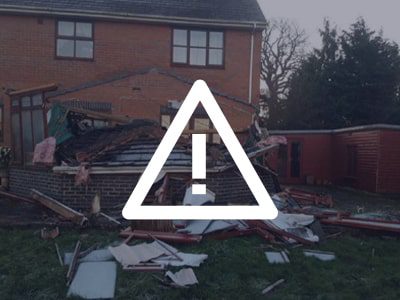
5 Dangers of Clad Over Roofs

If stepping into your conservatory in December feels like going on an Arctic expedition, you’re probably in need of better roof insulation.
A properly insulated roof will keep your conservatory cosy in the winter and cool in the summer. It will cut down on noise during rainy or windy weather, and save you money on your bills by increasing your home’s energy efficiency.
Unfortunately, some companies choose to prey on homeowners hoping for a conservatory they can enjoy year round. These companies offer to insulate your old conservatory roof with a special type of cladding, sparing you the time and money you would normally need to spend on a roof replacement… but the end result is far from what you’d hope.
Trade Price have carried out hundreds of high-quality solid roof installations across the South. In this post, we explain five risks of installing cladding over your conservatory roof.
1. Weakened Structural Integrity
Usually, clad over roofs are made using a combination of plasterboard, timber, tiles, and an insulating material. These are fitted to the conservatory’s glass or polycarbonate roof in a method that involves drilling into the glazing bars. Another layer of timber, a thermal quilt, and PVC cladding are then laid on top.
The glazing bars are there to support the glazing, drain excess water, and ventilate the room. Damaging them with drilling and excess weight is a surefire way of weakening the integrity of your structure.
Most glass or polycarbonate roofs don’t have the strength to carry a solid roof, especially in snow or strong winds. They are likely to collapse under the strain, jeopardising the lives of anyone nearby.
2. Condensation
When over-cladding is installed, the original aluminium bars and beams are left in place with no thermal barrier. Condensation is sure to follow, leading to:
- Leaks
- Damp
- Rot
- Mould
- Cracked plaster
All of these will require a costly round of treatment, further adding to the amount you’ll have to pay.
3. Fire Hazards
When testing a structure’s fire safety, all components are looked at as a whole. Solid roofs are only considered safe if they are rated as AC, AB, or AA in accordance with BS476-3.
Clad over systems come in separate components and vary from roof to roof, meaning they cannot be properly tested. You can’t know if a clad over roof is a serious fire hazard until it’s already too late.
4. Against Building Regulations
According to the Building Regulations 2010, you need to get building regulations approval when altering the roof of your home.
Clad over systems almost never get Building Regulation Approval due to the risk they pose. This could result in your local authority forcing you to pay for faulty work to be fixed. You will also not be granted a certificate of compliance if you wish to sell your home in the future.
5. Lowered House Value
Installed properly, a solid conservatory roof will add value to your home because of its energy efficiency. A clad over roof will have the opposite effect.
Not only will it add zero value to your home, but you’ll need to pay for a clad over roof to be totally removed and replaced when it comes time to sell. Instead of shelling out for one installation, you’ll have paid for two – as well as removal!
Clad over roofs aren’t just bad for your wallet – they pose a real risk to you and your family. That’s why you should only invest in a roof replacement from a trustworthy, fully certified installation company.
Trade Price’s highly accredited experts have years of experience installing high-quality solid conservatory roofs. We specialise in installing the most thermally efficient roof system on the market, the Warmer Roof PLUS, saving you money both in the short term and the long.
To get a quote on a solid roof conversion, fill out our online form or call us on 01202 399999.


